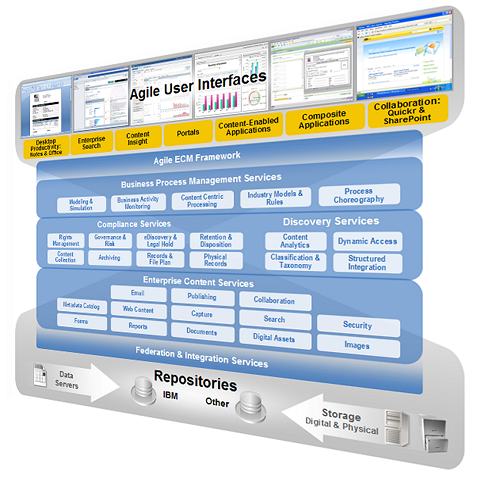IBM's Enterprise Content Management Strategy: Bigger than ERP?
Broader and Deeper; Redefines Both Content and Management
IBM's vision for ECM encompass all the activities involved in creating, using, managing and extracting value from unstructured information, both physical and electronic. IBM is bringing an ERP-style vision for content management to a world that suffers separate, uncommunicative applications for each enterprise function. The full value of unstructured information can never be achieved until we move from fragmented content tools to enterprise content services.
NETTING IT OUT
IBM's vision for ECM redefines content to include physical as well as electronic information and goes far beyond documents to include media and social content. IBM has also redefined management to encompass all the activities involved in creating, using, managing, and extracting value from unstructured information.
This broad vision will be valuable for everyone struggling with unstructured information – and that's everyone. We need help getting our unstructured act together. IBM is bringing an ERP-style vision for content management to a world that suffers separate, uncommunicative applications for each enterprise function. The full value of unstructured information can never be achieved until we move from fragmented content tools to enterprise content services.
Culture and habits are the main impediments to completing that journey, now that content technologies are delivering unprecedented automation. But technology still has some evolutionary ground to cover: we need a top-to-bottom stack that works as well for unstructured information as it does for transactional data.
ECM: BROAD AND SOMEWHAT OVERWHELMING SPACE
Unstructured Information Predominates
Unstructured information – the information that can't be stuffed neatly into rows and columns of database tables— is 80 percent of the business information we all deal with, and this percentage is unlikely to diminish. We keep inventing new kinds of unstructured information, and each of us is equipped with a multimedia publishing powerhouse on our laptops – and on our cell phones. Unstructured information is not only the predominant segment of our business information, it is the unwieldy segment. The other 20 percent – the transactional data – has been the focus of four decades of industry effort, as operating systems, programming languages, tools, applications, and, finally, enterprise resource planning systems (ERP) evolved to create and wring value from it. The computing infrastructure was developed to fit like a glove around transactional data: massive storage, rapid arithmetic, endless printing, wide communications, complex interrelationships based on architected patterns, and meticulously specified rules.
Creeping Problems and Point Solutions
But the transactional data glove doesn't entirely fit the unstructured information hand. Yes, much of the computing infrastructure works well for unstructured data – in particular storage, communications, and printing. What doesn't fit as well is the presumption of structure, explicit relationships, and rules. In its natural state, unstructured information inherently lacks the bits that the transaction-oriented infrastructure uses to create relationships and execute processes. These bits need to be added. Over the past four decades, the bits have been added first by people, then by applications supporting people, and finally by various automated analyses. This has been the gradual emergence of what is generally called records management, document management, and content management, individual systems devised to deal with individual forms of information.
The problems or pains organizations feel due to the unstructured information swirling about them have myriad manifestations. In fact, any particular type of information – paper correspondence, email, technical documentation, incidents, Web pages, press releases, loan applications, research notes, competitive analyses, resumes – might simultaneously cause different pains to several organizations within the same company. The correspondence that has lawyers worried about disclosure and discovery has facilities worried about the cost per square foot of filing space and the secretarial pool worried about the cost of keeping the files properly organized. Historically, each group has tended to deal with its own view of each problem in the manner most effective for its immediate goals. For example:
- Paper needing to be archived in safer or cheaper storage
- Business critical processes centered on documents needing visibility and metrics
- Content creation and publishing needing better control and efficiency
- Information with long lifecycle requiring reuse, modularity, and high accuracy
- Legal discovery and legal hold
- Email archiving
- Employees needing better access to corporate information via better findability
- Customers able to self-serve via more complete publishing and information organization
- Records retention for regulatory or compliance purposes
This list makes clear that unstructured information problems are broad and pervasive. But companies have been deploying shards, or fragments of solutions, to address unstructured information. This has been in large part because, until recently, the solutions have been fragmented as well. IBM's vision for enterprise content management sweeps up all those fragments and fits them into an omnibus solution.
IBM ASSEMBLES ECM PLATFORM
New Definitions for "Content" and "Management"
You'd expect anything with "enterprise" in its name to be pretty big. I have to say that IBM's Enterprise Content Management Platform is breath-taking for its breadth. First of all, it redefines the meaning of "content." Most of us think of content as electronic files that are mostly text, such as Office files, Web pages, PDFs, emails, and the like. IBM expands the definition of content to include all types of records and archives (paper!), tweets, audio, and video. Whereas content management has traditionally (for at least a decade now) meant creating it, filing it, revising it, publishing it, and possibly getting rid of it, IBM doesn't stop there. No, IBM's platform provides a broad set of services covering all the ways organizations interact with unstructured information...
IBM ECM Platform

© 2009 IBM
Illustration 1. IBM’s enterprise content management (ECM) platform is comprised of multiple repository technologies, the ECM framework, and user interfaces. The ECM framework is a layered architecture of data integration services, common content services, and higher-level business services.
Sign in to download the full article
0 comments
Be the first one to comment.



